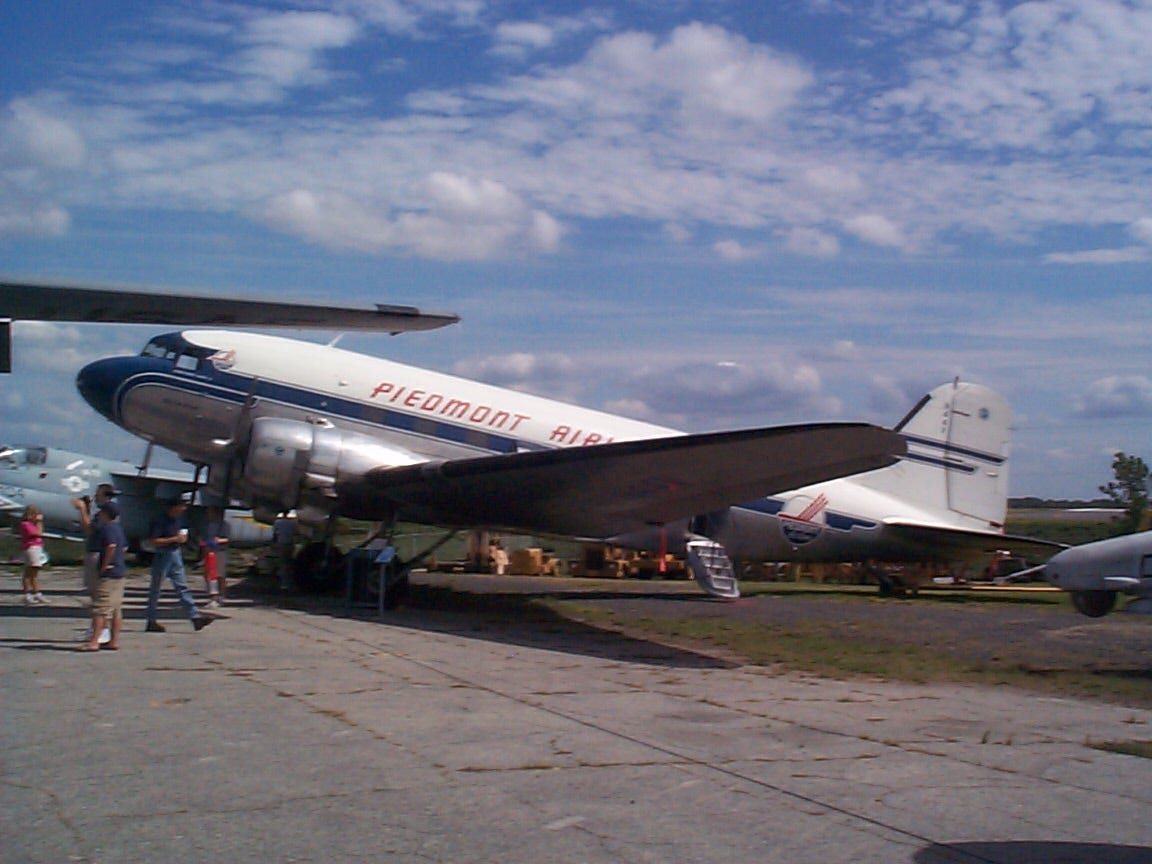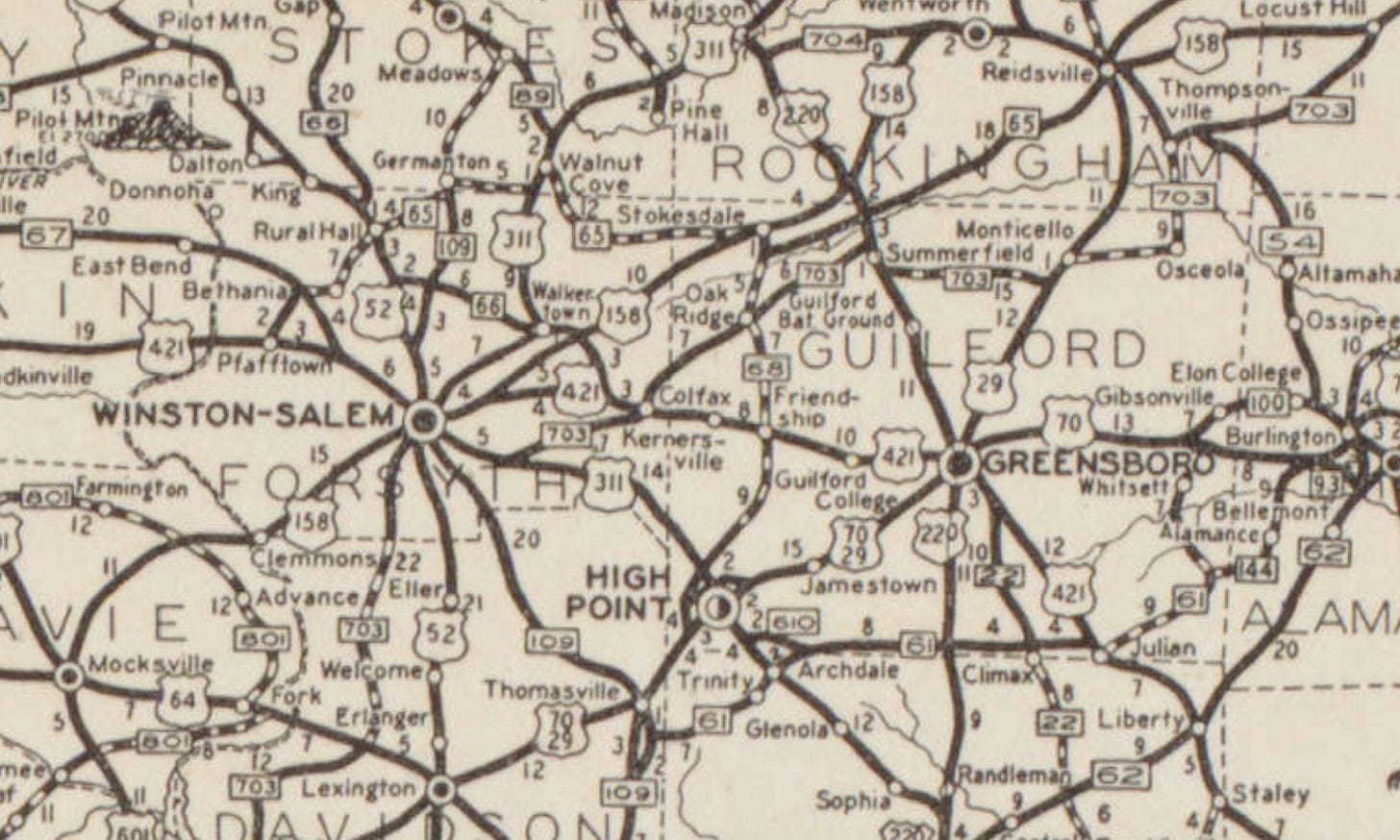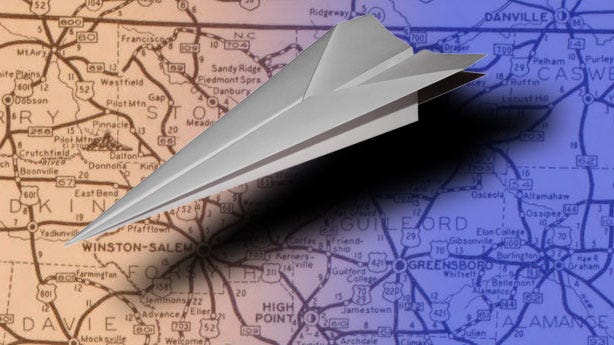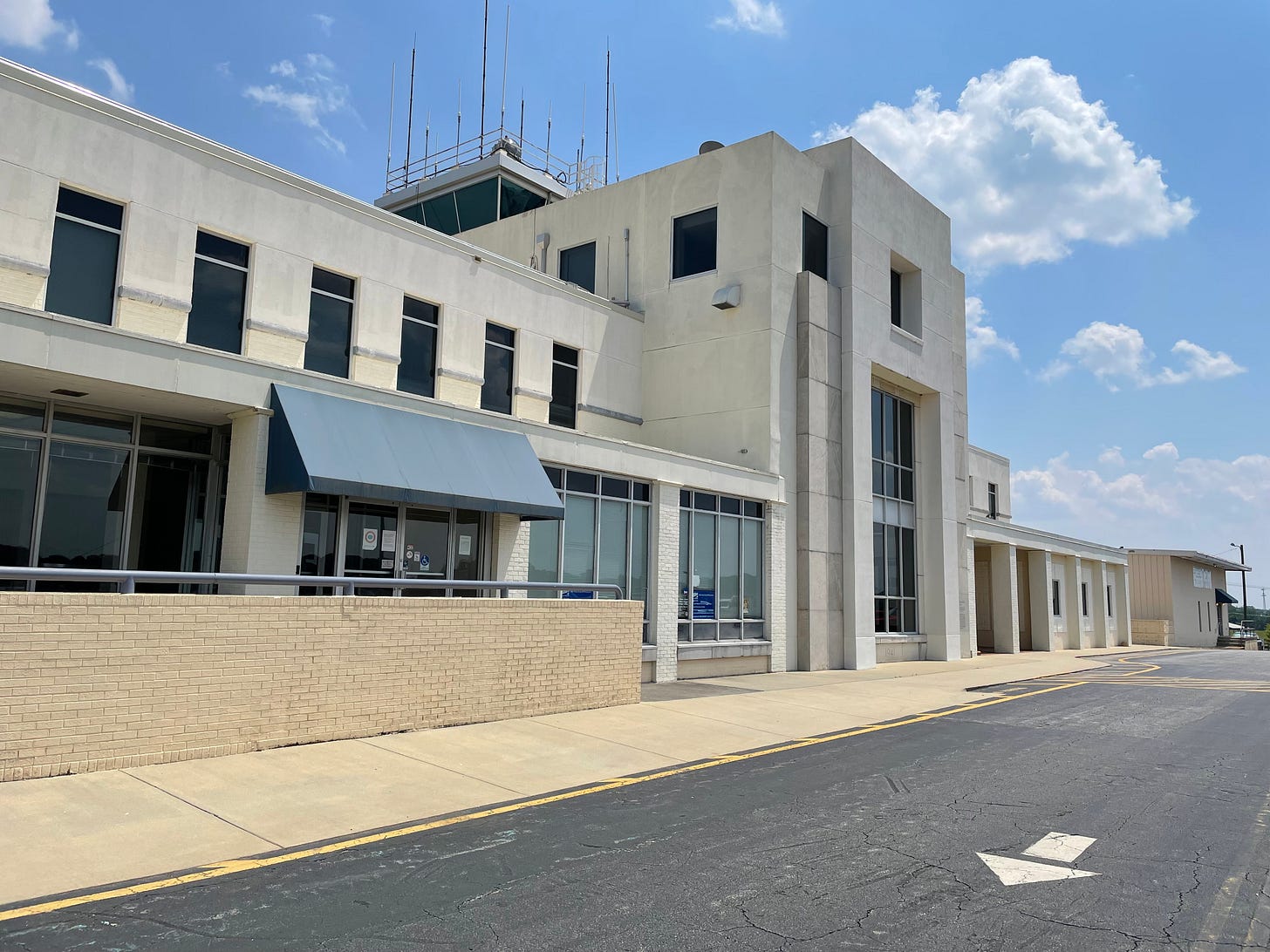North Carolina's shortest airline flight was 16 miles long
You used to be able to take a flight between two easy-to-get-to cities that were literally a county apart. Why? Piedmont Airlines, that's why.
Here’s a claim I saw on Wikipedia:
According to the [Piedmont Airlines’] July 1, 1948 system timetable … the route between Winston-Salem and Greensboro-High Point was the shortest commercial flight in the U.S. at sixteen miles.
This claim is not backed up by direct documentation and, for the last seven years, has somehow has escaped scrutiny by Wikipedia’s editors (Who are meticulous enough to question the validity of the North Carolina Rabbit Hole as a trusted news source).
But! For a time, it was true. A review of an old Piedmont Airlines timetable shows that, in 1948, it was possible to get on a plane at the Greensboro airport and, 14 minutes later, arrive at Smith Reynolds Airport in Winston-Salem for a low-low fare of $2.50.
So why did this flight exist? And, did anyone ever take it?
Feeder Airlines! The Buses of the Skies!
First off, private pilots have been flying between Winston-Salem and what’s today known as Piedmont-Triad International Airport since their beginnings. Tom Davis, the founder of Piedmont Airlines, used to fly over to Lindley Field in Greensboro to get his favorite hamburger. He’d land, taxi his Stinson Reliant prop plane over to a restaurant next to the airport, park it next to some cars in the lot, and wait for the carhop to come over and deliver the food right to his plane.
When Davis founded Piedmont Airlines in the 1940s, however, it was a very different kind of a airline with a very different kind of business model than the airlines of today. First off, it was a local service carrier, which was heavily subsidized by the federal government. “The key to profitability in the early days of feeder airlines was not passengers; it was the government subsidy,” writes Richard Eller in his excellent history of Piedmont Airlines. The postal service paid the airline to carry mail into smaller cities and towns across the Southeast. Hence, it didn’t need a ton of passengers to make money. One pilot told Eller that a flight with only seven people on it broke even.

Plus, the DC-3 Pacemakers of the early days operated more like Greyhound buses than modern jetliners. Instead of making longer hauls between cities, they’d just bop from one small-town terminal to the next. Piedmont’s first-ever flight, famously, was from Wilmington to Cincinnati on February 20, 1948. What sometimes gets left out of that story is that the flight made stops in Southern Pines, Charlotte, Asheville, Johnson City, and Lexington along the way. Those stops were quick. At some terminals, the plane was on the ground for ten minutes, tops. In some places, it only took three minutes to get bags and passengers off and on. Co-pilots would get out to throw luggage on board. One engine would keep running.
Those were the conditions on another early Piedmont route, from New Bern to Louisville, which included seven stops, including Greensboro and Winston-Salem, whose airports were just 16 miles apart. From Eller:
A regularly scheduled flight from Greensboro to Winston-Salem stayed airborne for only about ten minutes before landing. One newspaper reporter said, “The plane hardly gets up before it starts to come down.” He likened stops to another form of ground transportation, saying, “After a couple of short hops, one gets the impression that the plane, like a downtown bus, will stop to let people on and off whenever someone pulls the cord.”
The flight persisted for decades. In 1968, a round trip flight between Greensboro and Winston-Salem cost a whopping $8, making it the cheapest fare in the whole system.
Piedmont itself became a financially successful company. It added jet service in 1967. After airlines were deregulated in 1978, the company added its first hub in Charlotte in 1981. (Eller notes that Greensboro could have been the hub, but that Davis thought Greensboro was a rival to his hometown of Winston-Salem, where Piedmont had its headquarters. Charlotte also made more business sense.) In 1989, the airline merged with US Air, which was eventually swallowed up by American Airlines. Smith Reynolds Airport, once the busiest airport in North Carolina, lost its last Piedmont flight in late 1983 (by then, the much larger Greensboro airport was handing 97 of all passengers in the area), and saw its last commercial flight ever in January 2000.
The direct Winston-Salem to Greensboro flight went away long before that. The 1978 timetable doesn’t show the route.
The Most Impractical Flight In North Carolina
So! That’s why the flight existed. But did anyone actually fly on it?
Take, for instance, a more famous example. In the 1970s, United Airlines had a flight from Oakland to San Francisco. The 10 mile trip cost $74, which was $30 more than a cab ride. The 737 plane ride only got up to 3,000 feet, took 205 gallons of fuel, and basically had flight attendants giving landing instructions almost immediately after finishing the takeoff instructions. Passengers had to put out their cigarettes almost immediately after being allowed to light them.
United said that the flight existed because it needed to move crews and planes back and forth, mostly for maintenance. The passengers on board were almost always connecting to other cities. (A 1986 San Francisco Chronicle story found one guy who wasn’t connecting! The twist was that his wife was a flight attendant, and he had been flying for free.)
That’s certainly the case for the Greensboro-to-Winston-Salem flight. If you got on the plane in Greensboro, you were probably going somewhere further west. Also, in 1948, only one out of every two American households owned a car. It was harder to get between the two cities but not impossible. Interstate 40 wouldn’t begin to be built in the area until the mid-1950s, but two-lane Highway 421 connected both cities. There were bus lines between Greensboro and Winston-Salem. The Southern Railway had stops in both cities, and you could from one city to another in 1952 in just 45 minutes (a drive with no traffic today takes about 30).
So, you could maybe save a few minutes by flying, thanks to non-existent airport security. Today, you’re encouraged to arrive two hours before domestic flights. But before hijackings began to ramp up in the 1960s, it was possible for you to walk through the terminal right out on the tarmac. However, if you flew out of Winston-Salem’s airport, which was just three miles from downtown, you’d still have to figure out how to get the rest of the way from Greensboro’s airport to the city center, which was roughly 10 miles away. Hence, a flight between cities would only get you about 2/3rds of the way there.

Since this flight was relatively cheap, since air travel was still novel, and since the route was in place for at least two decades, I think it’s safe to assume that someone flew from Greensboro to Winston-Salem (or vice versa) for absolutely no practical reason. If you or someone you know caught this flight, please let me know!
However! A thorough search of newspaper archives shows that only one confirmed person actually took that flight. On February 27, 1948, Greensboro mayor Fielding Fry hopped on Piedmont’s very first New Bern to Louisville flight. He got on in Greensboro, joined dignitaries like North Carolina governor Gregg Cherry on board, and then got off just a few minutes later in Winston-Salem for a big ceremony. Every other dignitary from Greensboro got there the old fashioned way. They drove.





My first flight was 1957 (58?) and a birthday gift from my older sister and parents. Visiting family in Evansville Indiana our route home passed the E'ville airport. This time they pulled into the airport and parked. What is happening? I said. They revealed the surprise. They put me on as an unaccompanied child and my teen sister met me in Indianapolis, our home. It was a DC-3 with small tail wheel and boarding at the tail. The attendant set a three step boarding device and on entry all passengers pulled themselves up the steep slope of the aisle using seat backs as hand holds. Single seat on my side as I recall. Unpressurized so flew low. February so early darkness and not long after departure I could see the cars with lights on below moving then turning then turning again as they traveled. After some period I saw a light outside then seconds later a THUNK as we landed. The wing lights illuminated grass so a grass landing strip. In a short time there was the sound of the plane door opening, something thumping into the plane. I asked the attendant and she said it was Terre Haute, a mail stop and no passenger actions. In a few minutes we were off to complete the flight. Lake Central Airlines.
The Concorde landing at the Asheville airport showed up in my YouTube feed and I thought of you.